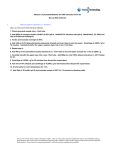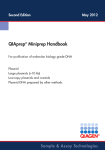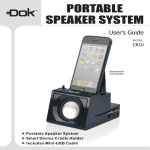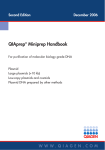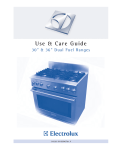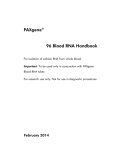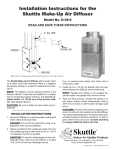Download QIAprep 96 Plus Miniprep Handbook
Transcript
April 2012 QIAprep® 96 Plus Miniprep Handbook QIAprep 96 Plus Miniprep Kit QIAprep 96 Plus BioRobot® Kit For 96-well preparation of up to 50 μg of high-quality plasmid DNA from E. coli Sample & Assay Technologies QIAGEN Sample and Assay Technologies QIAGEN is the leading provider of innovative sample and assay technologies, enabling the isolation and detection of contents of any biological sample. Our advanced, high-quality products and services ensure success from sample to result. QIAGEN sets standards in: Purification of DNA, RNA, and proteins Nucleic acid and protein assays microRNA research and RNAi Automation of sample and assay technologies Our mission is to enable you to achieve outstanding success and breakthroughs. For more information, visit www.qiagen.com. Contents Kit Contents 4 Storage 4 Intended Use 4 Safety Information 5 Quality Control 5 Introduction 6 Principle and procedure Equipment and Reagents to Be Supplied by User Important Notes 6 9 10 Assembly of the QIAvac 96 vacuum manifold 11 Cell cultivation in a 96-well Flat-Bottom Block 12 Cell cultivation in a 24-well block 12 Protocol: Plasmid DNA Purification using the QIAprep 96 Plus Miniprep Kit Use of a centrifuge for the QIAprep 96 Plus Miniprep procedure 15 18 Troubleshooting Guide 21 Appendix A: Setup of the QIAvac 96 23 Appendix B: Agarose Gel Analysis of the Purification Procedure 25 Ordering Information 27 QIAprep 96 Plus Miniprep Handbook 04/2012 3 Kit Contents QIAprep 96 Plus Miniprep Kit (4) QIAprep 96 Plus BioRobot Kit (4) 27291 962241 4 4 Buffer P1 150 ml 2 x 250 ml Buffer P2 140 ml 2 x 250 ml Buffer S3 160 ml 2 x 160 ml Buffer BB 160 ml 2 x 160 ml Buffer PE (concentrate) 100 ml 2 x 100 ml 55 ml 2 x 55 ml RNase A (100 mg/ml) 15 mg 2 x 25 mg TurboFilter® 96 Plates 4 4 Plasmid Plus 96 Plates 4 4 Tape Pad 1 1 Flat-Bottom Blocks 4 4 S-Blocks 4 4 Elution Microtubes (racked) (96) 4 4 Quick-Start Protocol 1 1 Kit Catalog no. Number of preps Buffer EB Storage QIAprep 96 Plus Miniprep and BioRobot Kits should be stored dry at room temperature (15–25°C). Kits can be stored for up to 1 year without showing any reduction in performance and quality. After adding RNase A, Buffer P1 should be stored at 2–8°C and is stable for 6 months. Other buffers and RNase A stock solution can be stored for 2 years at room temperature. Intended Use QIAprep 96 Plus Miniprep and BioRobot Kits are intended for molecular biology applications. These products are not intended for the diagnosis, prevention, or treatment of a disease. 4 QIAprep 96 Plus Miniprep Handbook 04/2012 All due care and attention should be exercised in the handling of the products. We recommend all users of QIAGEN® products to adhere to the NIH guidelines that have been developed for recombinant DNA experiments, or to other applicable guidelines. Safety Information When working with chemicals, always wear a suitable lab coat, disposable gloves, and protective goggles. For more information, please consult the appropriate material safety data sheets (MSDSs). These are available online in convenient and compact PDF format at www.qiagen.com/Support/MSDS.aspx where you can find, view, and print the MSDS for each QIAGEN kit and kit component. 24-hour emergency information Emergency medical information in English, French, and German can be obtained 24 hours a day from: Poison Information Center Mainz, Germany Tel: +49-6131-19240 Quality Control In accordance with QIAGEN’s ISO-certified Quality Management System, each lot of the QIAprep 96 Plus Miniprep and BioRobot Kits is tested against predetermined specifications to ensure consistent product quality. QIAprep 96 Plus Miniprep Handbook 04/2012 5 Introduction QIAprep 96 Plus Miniprep and BioRobot Kits provide a novel method for plasmid preparation. The procedure is based on a nonchaotropic binding chemistry. Following lysate clearing, a simple bind-wash-elute procedure results in highly concentrated plasmid DNA, ready for direct use in subsequent applications. The unique kit chemistry and design of the Plasmid Plus 96 plates allow high binding capacities. QIAprep 96 Plus Miniprep and BioRobot Kits provide highly pure DNA, suitable for transfection into robust cell lines, for preparation of short hairpin vectors (shvectors), as well as for routine applications such as enzymatic modifications, cloning, restriction digestion, and in vitro transcription/translation. Principle and procedure The QIAprep 96 Plus Miniprep protocol is based on a modified alkaline lysis procedure. After neutralization, lysates are cleared by using a TurboFilter 96 plate. A nonchaotropic binding buffer (Buffer BB) is added to the cleared lysate to optimize plasmid DNA binding to the membrane of the Plasmid Plus 96 plate. The unique binding buffer provides very specific binding conditions leading to DNA quality that is comparable to anion-exchange preps. Due to the proprietary binding chemistry, up to 50 μg plasmid DNA per well can be obtained from a 5 ml E. coli culture. The DNA yield depends on the plasmid copy number and the amount of E. coli culture used. The procedure may be automated using QIAprep Plus 96 BioRobot Kit (4) (cat. no. 962241) on the BioRobot Universal System. The QIAvac 96 is used for lysate clearing using the TurboFilter 96 plate, and DNA binding and wash steps using the Plasmid Plus 96 plate. Drying and elution steps may be performed either on the QIAvac 96 or using a compatible centrifuge. Alternatively, the complete procedure can be performed by using a compatible centrifuge. 6 QIAprep 96 Plus Miniprep Handbook 04/2012 Table 1. Typical yields of plasmid DNA from different volumes of E. coli culture E. coli culture volume (LB medium) Typical DNA yield 1.25 ml Up to 15 μg 2.5 ml Up to 30 μg 5 ml* Up to 50 μg * When using a 5 ml culture, the volumes of the lysis buffers may be slightly increased. Use 350 μl Buffer P1, 350 μl Buffer P2, 350 μl Buffer S3, and 300 μl Buffer BB. If high DNA yields are expected, the elution volume may be increased to 100–120 μl. QIAprep 96 Plus Miniprep Handbook 04/2012 7 8 QIAprep 96 Plus Miniprep Handbook 04/2012 Equipment and Reagents to Be Supplied by User When working with chemicals, always wear a suitable lab coat, disposable gloves, and protective goggles. For more information, consult the appropriate material safety data sheets (MSDSs), available from the product supplier. Standard microbiological equipment for growing and harvesting bacteria (e.g., inoculating loop, culture tubes and flasks, and 37°C shaking incubator) Centrifuge with rotor for 96-well blocks. We recommend QIAGEN’s Centrifuge 4-16 (cat. no. 80310) for room-temperature centrifugation, and for refrigerated centrifugation, we recommend QIAGEN’s Centrifuge 4-16K (cat. no. 81410). 96–100% ethanol Vacuum pump (e.g., QIAGEN Vacuum Pump [cat. no. 84010]) QIAvac 96 (cat. no. 19504) Elution Microtube Adapter (available from QIAGEN Technical Services) for QIAvac 96 for the elution step using the QIAvac 96. Alternatively, an empty microplate may be used to adjust the height of the elution microtubes or the elution step could be performed in a suitable centrifuge where no adapter is necessary. If the drying step is performed in a suitable centrifuge (optional), additional S-Blocks (Square-Well Blocks) or elution microtubes are required. If the complete procedure is performed using a centrifuge, additional SBlocks are required. QIAprep 96 Plus Miniprep Handbook 04/2012 9 Important Notes Please take a few moments to read this handbook carefully before beginning the DNA preparation. If QIAGEN plasmid purification kits are new to you, please visit our plasmid resource page at www.qiagen.com/goto/plasmidinfo and click the link “General Considerations for Optimal Results”. Also be sure to read and follow the appropriate detailed protocol. Plasmid copy number Plasmid and cosmids vary in copy number, depending on the origin of replication they contain, their size, and the size of insert. For more details, visit our plasmid resource page at www.qiagen.com/goto/plasmidinfo and click the link “General Considerations for Optimal Results”. Host strains The strain used to propagate a plasmid can have a substantial influence on quality of the purified DNA. Host strains such as DH1, DH5®, and C600 yield high-quality DNA with QIAGEN protocols. The slower growing strain XL1-Blue also yields DNA of very high quality. Strain HB101 and its derivatives, such as TG1 and the JM100 series, contain large amounts of carbohydrates that are released during lysis and can inhibit enzyme activities if not completely removed. In addition, some strains, such as JM101, JM110, and HB101, have high levels of endonuclease activity and yield DNA of lower quality. If the quality of purified DNA is not as expected, a change of host strain should be considered. If difficulty is encountered with strains such as TG1 and Top10F, we recommend reducing the amount of culture volume to improve the ratio of biomass to lysis buffers for optimized lysis conditions. Culture media QIAGEN plasmid purification protocols are optimized for use with cultures grown in Luria Bertani (LB) medium. Please note that a number of slightly different LB culture broths, containing different concentrations of NaCl, are commonly used. We recommend growing cultures in LB medium containing 10 g NaCl per liter, prepared as described on the following page, to obtain the highest plasmid yields. In general, we do not recommend using rich media with our plasmid kits. Using rich media might lead to clogging of the filter. If this is the case, growth time must be optimized, and culture volumes reduced. For more details, visit our plasmid resource page at www.qiagen.com/goto/plasmidinfo and click on the link “General Considerations for Optimal Results”. 10 QIAprep 96 Plus Miniprep Handbook 04/2012 Preparation of LB medium Dissolve 10 g tryptone, 5 g yeast extract, and 10 g NaCl in 800 ml distilled water. Adjust the pH to 7.0 with 1 N NaOH. Adjust the volume to 1 liter with distilled water. Sterilize by autoclaving. Culture volume Do not exceed the maximum recommended culture volumes. Using larger culture volumes will lead to an increase in biomass and can affect the efficiency of alkaline lysis, leading to reduced yield and purity of the preparation. The QIAprep 96 Plus Miniprep protocol is optimized for use with cultures grown in Luria Bertani (LB) medium, grown to a cell density of approximately 3–4 x 109 cells/ml. It is best to assess the cell density of the culture and, if it is too high, reduce the culture volumes accordingly. A high ratio of biomass to lysis buffers will result in poor lysis conditions and subsequently low DNA yield and purity. For determination of cell density, calibration of each individual spectrophotometer is required to facilitate accurate conversion of OD600 measurements into the number of cells per milliliter. This can be achieved by plating serial dilutions of a culture onto LB-agar plates in the absence of antibiotics. The counted colonies are used to calculate the number of cells per milliliter, which is then set in relation to the measured OD600 values. Assembly of the QIAvac 96 vacuum manifold The QIAvac 96 must be assembled before starting the QIAprep 96 Plus Miniprep protocol. Refer to Appendix A, page 23, for further details. 1. Place an S-Block inside the QIAvac base. 2. Place the QIAvac 96 top plate over the base. 3. Place the TurboFilter 96 plate into the QIAvac top plate. Make sure that the plate is seated securely. The S-Block should now be positioned under the TurboFilter 96 plate. 4. 5. 6. 7. Attach the QIAvac 96 to a vacuum source. Seal the TurboFilter 96 plate with tape and apply vacuum. Using a vacuum regulator, adjust vacuum to –300 mbar. Remove the tape. QIAprep 96 Plus Miniprep Handbook 04/2012 11 Table 2. Pressure conversions To convert from millibars (mbar) to Multiply by Millimeters of mercury (mm Hg) 0.75 Kilopascals (kPa) 0.1 Inches of mercury (inch Hg) 0.0295 Torrs (Torr) 0.75 Atmospheres (atm) 0.000987 Pounds per square inch (psi) 0.0145 Cell cultivation in a 96-well Flat-Bottom Block 1. Fill each well of a 96-well Flat-Bottom Block with 1.3 ml of growth medium containing the appropriate selective agent. 2. Inoculate each well from a single bacterial colony or pre-culture. 3. Incubate the cultures for 20–24 h at 37°C with vigorous shaking. The wells in the block may be protected against spill-over by covering the block with an AirPore tape sheet (cat. no. 19571). AirPore microporous tape sheets promote gas exchange during culturing. If nonporous tape is used, pierce 2–3 holes in the tape with a needle above each well for aeration. 4. Harvest the bacterial cells in the block by centrifugation for 5 min at 2100 x g in a centrifuge with a rotor for a 96-well adapter (e.g., QIAGEN’s Centrifuge 4-16K, or Heraeus® Minifuge GL), preferably at 4–10°C. The block should be covered with adhesive tape during centrifugation. Remove media by inverting the block. To remove the media, peel off the tape and quickly invert the block over a waste container. Tap the inverted block firmly on a paper towel to remove any remaining droplets of medium. IMPORTANT: Ensure that the buckets on the rotor have sufficient clearance to accommodate the 2 ml Flat-Bottom Blocks before starting the centrifuge. Cell cultivation in a 24-well block To obtain high plasmid yields of up to 50 μg, a 5 ml LB culture volume per well is used for plasmid preparation. E. coli cultures can be grown and harvested in 24-well blocks. We do not recommend rich media here, as the higher amount of biomass may lead to clogging of the TurboFilter 96 plate. To ease growth of E. coli cultures in parallel, cultures can be grown and harvested in 24-well blocks (e.g., QIAGEN’s 24-Well Blocks RB [cat. no. 19583]). 12 QIAprep 96 Plus Miniprep Handbook 04/2012 Procedure 1. Fill each well of a 24-well block with 5 ml of LB medium containing the appropriate selective agent. 2. Inoculate each well from a single bacterial colony or pre-culture. 3. Carefully seal the block with an AirPore tape sheet (cat. no. 19571). 4. Incubate the cultures for 16–24 h at 37°C with vigorous but appropriate shaking. 5. Harvest the bacterial cells in the block by centrifugation for 5 min at 2100 x g in a centrifuge with a rotor for a 96-well adapter (e.g., QIAGEN’s Centrifuge 4-16K, or Heraeus Minifuge GL), preferably at 4–10°C. The block should be covered with adhesive tape during centrifugation. Remove media by carefully inverting the block. Proceed as described in the section “Transfer from 24-well format to 96-well format”. To remove the media, peel off the tape and quickly invert the block over a waste container. Tap the inverted block carefully on a paper towel to remove any remaining droplets of medium. Alternatively, the cultures may be harvested using a Flat-Bottom Block, where aliquots of each of the 5 ml cultures are collected per well by centrifugation with subsequent removal of medium. IMPORTANT: Ensure that the buckets on the rotor have sufficient clearance to accommodate the 24-well blocks before starting the centrifuge. QIAprep 96 Plus Miniprep Handbook 04/2012 13 Transfer from 24-well format to 96-well format To transfer from 24-well format to 96-well format, the samples may be transferred to a 96-well flat bottom block after resuspension of pelleted bacteria with Buffer P1 (step 1 of the purification protocol). Alternatively, steps 1–3 of the purification protocol can be performed within the wells of the 24-well blocks. For subsequent lysate clearing, the lysates are directly transferred from the wells of the 24-well blocks to the wells of the TurboFilter 96 plate. The following pipetting scheme may be used for transfer of the lysates. Transfer from the 24-well block may be performed by using every second channel of an 8-channel pipet. Transfer lysates from the first block to rows 1–6, only to lanes A, C, E, and G of the Flat Bottom Block or TurboFilter 96 plate. Transfer lysates from the second block to rows 7–12, only to lanes A, C, E, and G of the Flat Bottom Block or TurboFilter 96 plate. Transfer lysates from the third block to rows 1–6, only to lanes B, D, F, and H of the Flat Bottom Block or TurboFilter 96 plate. Transfer lysates from the fourth block to the rows 7–12, only to lanes B, D, F, and H of the Flat Bottom Block or TurboFilter 96 plate. Block 1 Block 2 Block 3 Block 4 Lanes Figure 1. 24-well blocks 1–4. A B C D E F G H 1 1 3 1 3 1 3 1 3 2 1 3 1 3 1 3 1 3 Rows of the 3 4 5 1 1 1 3 3 3 1 1 1 3 3 3 1 1 1 3 3 3 1 1 1 3 3 3 TurboFilter 96 plate 6 7 8 9 10 1 2 2 2 2 3 4 4 4 4 1 2 2 2 2 3 4 4 4 4 1 2 2 2 2 3 4 4 4 4 1 2 2 2 2 3 4 4 4 4 11 2 4 2 4 2 4 2 4 12 2 4 2 4 2 4 2 4 Figure 2. Lanes and rows of the 96-well TurboFilter 96 plate to which lysates from the 24-well blocks are transferred according to the given numerical scheme. 14 QIAprep 96 Plus Miniprep Handbook 04/2012 Protocol: Plasmid DNA Purification using the QIAprep 96 Plus Miniprep Kit This protocol is designed for the preparation of up to 50 μg high-copy plasmid DNA using the QIAprep 96 Plus Miniprep Kit with a maximum culture volume (i.e., LB medium) of 5 ml per well. Important points before starting Wear safety glasses when working near a vacuum manifold under pressure. Always place the QIAvac 96 manifold on a secure bench top or work area. For safety reasons, do not use 96-well plates that have been damaged in any way. To avoid the possibility of implosion, do not use any vessel/material that is not designed for use with a vacuum. Do not use any material that is cracked or scratched. Optional: samples can be removed after step 5 of the protocol to monitor the procedure on an analytical gel. Switch off the vacuum source between steps to ensure that a consistent, even vacuum is applied during vacuum steps. When using a 5 ml culture, the volumes of the lysis buffers may be slightly increased; use 350 μl Buffer P1, 350 μl Buffer P2, 350 μl Buffer S3, and 300 μl Buffer BB. If high DNA yields are expected, the elution may be increased to 100–120 μl. Things to do before starting Add the provided RNase A solution to Buffer P1 before use. Use 1 vial RNase A (centrifuge briefly before use) per bottle Buffer P1 for a final concentration of 100 μg/ml. Add ethanol (96–100%) to Buffer PE before use (see bottle label for volume). Check Buffer P2 and Buffer BB for precipitation due to low storage temperature and, if necessary, dissolve by warming to 37°C. Close the bottle containing Buffer P2 immediately after use to avoid acidification of Buffer P2 from CO2 in the air. Assemble the QIAvac 96 as described on page 12. The vacuum should be regulated to –300 mbar before beginning the procedure. QIAprep 96 Plus Miniprep Handbook 04/2012 15 Procedure 1. Resuspend pelleted bacteria in 300 μl Buffer P1. IMPORTANT: Ensure that RNase A has been added to Buffer P1. Note: Resuspend the bacterial pellet completely by vortexing or pipetting up and down until no cell clumps remain. If frozen cells are used, make sure that the cells are completely thawed (also in the centre of the Flat-Bottom Block). If cells were not harvested in a Flat-Bottom Block, transfer resuspended bacteria into the Flat-Bottom Block. 2. Add 300 μl Buffer P2 to each well. Dry the top of the Flat-Bottom Block thoroughly with a paper towel and seal the block with the tape provided. Gently invert the block upside down 6–8 times to mix and incubate at room temperature (15–25°C) for 5 min. Note: It is important to mix gently by inverting the block. Do not shake vigorously, as this will result in shearing of genomic DNA. If necessary, continue inverting the block until the solution becomes viscous and slightly clear. IMPORTANT: Do not allow the lysis reaction to proceed for more than 5 min. 3. Remove the tape from the block. Add 300 μl Buffer S3 to each well. Dry the top of the Flat-Bottom Block thoroughly with a paper towel and seal the block with new tape. Gently invert the block upside down 6–8 times to mix. Note: To avoid localized precipitation, mix the samples gently but thoroughly immediately after addition of Buffer S3. The solutions should become cloudy. 4. Remove the tape from the block. Transfer the lysates from step 3 into the wells of the TurboFilter 96 plate on the assembled QIAvac 96. Apply vacuum (–300 mbar) until all samples have passed through the wells of the TurboFilter 96 plate into the S-Block. Note: Unused wells of the TurboFilter 96 plate should be sealed with tape. 5. After all liquid has been drawn through the TurboFilter 96 plate, switch off the vacuum source and ventilate the QIAvac 96 slowly. Note: Discard the TurboFilter 96 plate after this step. 6. Add 300 μl Buffer BB to the cleared lysate in each well of the S-Block. Dry the top of the S-Block thoroughly with a paper towel and seal the block with a new tape. Invert the block upside down 1–3 times to mix. 16 QIAprep 96 Plus Miniprep Handbook 04/2012 7. Place a waste tray into the base of the QIAvac 96. Place the QIAvac 96 top plate over the base. Place the Plasmid Plus 96 plate in the top plate. Transfer the lysates from the S-Block to the Plasmid Plus 96 plate. Note: Unused wells of the Plasmid Plus 96 plate should be sealed with tape. 8. Apply vacuum until all samples have passed through. Note: After the liquid has been drawn through all wells, switch off the vacuum source and ventilate the QIAvac 96 slowly. 9. To wash the DNA, add 900 μl Buffer PE to each well of the Plasmid Plus 96 plate. Apply vacuum until all samples have passed through. Note: After the liquid has been drawn through all wells, switch off the vacuum source and ventilate the QIAvac 96 slowly. 10. To dry the membranes of the plate, use the QIAvac 96 with the centrifuge or a vacuum manifold. Note: This step removes residual Buffer PE from the membrane by airflow going through the wells. If using a centrifuge, place the Plasmid Plus 96 plate onto an S-Block or elution microtube rack with elution microtubes and centrifuge at 6000 x g for 10 min. IMPORTANT: S-blocks or elution microtubes required here are not provided with the kit. If using vacuum, empty the waste tray and put it back into the QIAvac 96 and apply maximum vacuum for 10 min. Switch off vacuum, and ventilate the QIAvac 96 slowly. Lift the top plate from the base (but not the Plasmid Plus plate 96 from the top plate), vigorously tap the top plate on a stack of absorbent paper until no drops come out, and blot the nozzles of the Plasmid Plus 96 plate with clean absorbent paper. Buffer PE removal is only effective when maximum vacuum is used (i.e., turn off vacuum regulator or leakage valves if they are used). QIAprep 96 Plus Miniprep Handbook 04/2012 17 11. To elute the DNA from the plate, use a centrifuge or the QIAvac 96. Note: Ensure that Buffer EB is dispensed directly onto the center of the Plasmid Plus 96 plate membrane for optimal elution of DNA. Average eluate volume is 65 μl from an elution buffer volume of 80 μl. If using a centrifuge: Place the Plasmid Plus 96 plate onto a new elution microtube rack containing elution microtubes. Add 80 μl of Buffer EB to the centre of each well of the Plasmid Plus 96 plate. Let it stand for 3 min and then centrifuge at 6000 x g for 1 min. If using the QIAvac 96: Replace the waste tray with the Elution Microtube Adapter. Alternatively, if no Elution Microtube Adapter is available, an empty 96-well microplate may be used. Place the elution microtube rack containing elution microtubes onto the adapter. Place the top plate back on the base, making sure that the Plasmid Plus 96 plate is seated securely. If a microplate is used instead of the Elution Microtube Adapter, please ensure that the nozzles of the Plasmid Plus 96 plate extend into the elution microtubes. Add 80 μl of Buffer EB to the centre of each well of the Plasmid Plus 96 plate. Let it stand for 3 min and then apply maximum vacuum for 1 min. Switch off the vacuum source and ventilate the QIAvac 96 slowly. Use of a centrifuge for the QIAprep 96 Plus Miniprep procedure The QIAprep 96 Plus Miniprep procedure may be performed using a centrifuge that is suitable for 96-well blocks. Before starting, check if the centrifuge can accommodate 96-well plates and the S-Block. Replace the vacuum steps with the centrifugation steps as described below. For further details individual steps of the purification procedure, refer to the protocol on pages 17–18. Lysate clearing with the TurboFilter 96 plate 1. After step 3 of the protocol, place the TurboFilter 96 plate on top of an S-Block. 2. Transfer the lysates onto the TurboFilter 96 plate. 18 QIAprep 96 Plus Miniprep Handbook 04/2012 3. Load the assembled components (TurboFilter 96 plate on the SBlock) into the rotor. 4. Centrifuge for 3 min at 3000 x g. Binding 5. After step 6 of the protocol, place the Plasmid Plus 96 plate on top of an S-Block. IMPORTANT: S-Blocks required in this step are not provided with the kit. 6. Transfer the lysates onto the Plasmid Plus 96 plate. 7. Load the assembled components (Plasmid Plus 96 plate on the SBlock) into the rotor. 8. Centrifuge for 1 min at 160 x g. Wash steps 9. Place the Plasmid Plus 96 plate on top of an S-Block. IMPORTANT: S-Blocks required in this step are not provided with the kit. 10. Add the respective wash buffers. 11. Load the assembled components (Plasmid Plus 96 plate on the SBlock) into the rotor. 12. Centrifuge for 1 min at 160 x g. Drying 13. Place the Plasmid Plus 96 plate on top of an elution microtube rack or a clean S-Block. IMPORTANT: S-Blocks required in this step are not provided with the kit. 14. Centrifuge for 10 min at 6000 x g. Elution 15. Place the Plasmid Plus 96 plate on top of a new elution microtube rack containing elution microtubes. 16. Add elution buffer (Buffer EB) as described in the protocol (page 18). 17. Load the assembled components (Plasmid Plus 96 plate on the elution microtubes) into the rotor. 18. Centrifuge for 1 min at 6000 x g. QIAprep 96 Plus Miniprep Handbook 04/2012 19 Determination of yield To determine the yield, DNA concentration should be determined by both UV spectrophotometry at 260 nm and quantitative analysis on an agarose gel. For reliable spectrophotometric DNA quantification, A260 readings should lie between 0.1 and 1.0. Agarose gel analysis We recommend removing and saving an aliquot of the cleared lysate (step 5). If the plasmid DNA is of low yield or quality, the sample and eluate can be analyzed by agarose gel electrophoresis to determine at the stage of the purification procedure where the problem occurred. See Appendix B for more information. 20 QIAprep 96 Plus Miniprep Handbook 04/2012 Troubleshooting Guide This troubleshooting guide may be helpful in solving any problems that may arise. For more information, see also the Frequently Asked Questions page at our Technical Support Center: www.qiagen.com/FAQ/FAQList.aspx. The scientists in QIAGEN Technical Services are always happy to answer any questions you may have about either the information and protocols in this handbook or sample and assay technologies (for contact information, see back cover or visit www.qiagen.com). Comments and suggestions Low or no yield No DNA in the cleared lysate before loading a) Plasmid did not propagate Check that the conditions for optimal growth were met. For more details, see www.qiagen.com/goto/plasmidinfo. b) Alkaline lysis was inefficient If cells have grown to very high densities or a larger amount of culture medium than recommended was used, the ratio of the biomass to lysis reagent is shifted. This may result in poor lysis conditions because the volumes of Buffers P1, P2, and S3 are not sufficient for efficient release of plasmid DNA. Reduce the culture volume to improve the ratio of biomass to lysis buffer. Also, insufficient mixing of lysis reagents will result in reduced yield. Mix thoroughly after addition of Buffers P1, P2, and S3 to achieve homogeneous suspensions. c) Buffer P2 or BB precipitated Redissolve by warming to 37°C. d) Cell resuspension incomplete Pelleted cells should be completely resuspended in Buffer P1. Do not add Buffer P2 until a homogeneous suspension is obtained. DNA is found in the wash flow-through Ethanol omitted from wash buffer Repeat procedure with correctly prepared wash buffer (Buffer PE). QIAprep 96 Plus Miniprep Handbook 04/2012 21 Comments and suggestions Low DNA quality Eluate contains residual Ensure that the membrane of the Plasmid Plus 96 ethanol omitted from plate is dried sufficiently using a centrifuge or wash buffer vacuum (see step 10 on page 18 of the protocol). TurboFilter 96 plate clogs during filtration a) Culture volume too large Do not exceed the culture volume recommended in the protocol. b) Inefficient mixing after addition of Buffer S3 Mix well until the solution is cloudy. Mix the samples immediately after addition of Buffer S3 to avoid local precipitation. c) Mixing too vigorous after addition of Buffer S3 After addition of Buffer S3, the lysate should be mixed immediately, but gently. Vigorous mixing disrupts the precipitate into tiny particles. d) Block was agitated Gently mix after addition of Buffer S3. Agitation causes shearing of DNA. e) The TurboFilter 96 plate was not loaded immediately after addition of Buffer S3 After addition of Buffer S3, the lysate should be transferred to the TurboFilter 96 plate immediately. f) Vacuum pressure was too low Ensure that the vacuum generates a vacuum pressure of –200 to –600 millibar (–150 to –450 mmHg). 22 QIAprep 96 Plus Miniprep Handbook 04/2012 Appendix A: Setup of the QIAvac 96 Guidelines for QIAvac manifolds The following recommendations should be followed when handling QIAvac manifolds. QIAvac manifolds operate with a house vacuum or Vacuum Pump (e.g., Vacuum Pump, cat. no. 84010 [USA and Canada], 84000 [Japan], or 84020 [rest of world]). Always store QIAvac manifolds clean and dry. To clean, simply rinse all components with water and dry with paper towels. Do not air dry, as the screws may rust and need to be replaced. Do not use abrasives or solvents. Always place the QIAvac manifold on a secure bench top or work area. If dropped, the manifold may crack. The components of QIAvac manifolds are not resistant to ethanol, methanol, or other organic solvents (Table 3). Do not bring solvents into contact with the vacuum manifold. If solvents are spilled on the unit, rinse thoroughly with distilled water. Ensure that no residual Buffer PE remains in the vacuum manifold. To ensure consistent performance, do not apply silicone or vacuum grease to any part of a QIAvac manifold. The spring lock on the top plate and the self-sealing gasket provide an airtight seal when vacuum is applied to the assembled unit. To maximize gasket lifetime, rinse the gasket free of salts and buffers after each use and dry with paper towels before storage. Table 3. Chemical-resistance properties of QIAvac manifolds Resistant to Not resistant to Chlorine bleach (12%) Acetic acid Benzene Hydrochloric acid Acetone Chloroform Sodium chloride Chromic acid Ethers Sodium hydroxide Phenol Toluene Urea Concentrated alcohols QIAprep 96 Plus Miniprep Handbook 04/2012 23 5 3 4 6 Figure 3. Components of the QIAvac 96 vacuum manifold. 1. QIAvac base, which holds a waste tray, S-Block, or Elution Microtube Adapter 2. Waste tray 3. QIAvac 96 top plate 4. Elution Microtube Rack with Elution Microtubes 5. 96-well plate (i.e., TurboFilter 96 or Plasmid Plus 96 Plate) 6. Elution Microtube Adapter (not included with the QIAvac 96; please contact QIAGEN Technical Services) 24 QIAprep 96 Plus Miniprep Handbook 04/2012 Appendix B: Agarose Gel Analysis of the Purification Procedure DNA yields and quality can be readily analyzed by agarose gel electrophoresis. Poor yields and quality can be caused by a number of different factors. To determine the stage of the procedure where a problem occurred, save a fraction of the cleared lysate and analyze by agarose gel electrophoresis. Preparation of samples Remove an aliquot from the cleared lysate as indicated in the protocol. Precipitate the nucleic acids by adding 1 volume of isopropanol, centrifuge for 15 min at maximum speed, and discard supernatant. Rinse the plasmid DNA pellets with 70% ethanol, drain well, and resuspend in 10 μl TE buffer, pH 8.0. Agarose gel analysis Run 2 μl of cleared lysate sample on a 1% agarose gel and compare to the eluted plasmid DNA as shown in Figure 4. 1 2 3 4 5 M2 Figure 4. Agarose gel analysis of the plasmid purification procedure. Lanes 1–5 illustrate some atypical results that may be observed in some preparations, depending on plasmid type and host strain. When working with chemicals, always wear a suitable lab coat, disposable gloves, and protective goggles. For more information, consult the appropriate material safety data sheets (MSDSs), available from the product supplier. QIAprep 96 Plus Miniprep Handbook 04/2012 25 Lane 1: Supercoiled (lower band) and open circular form (upper band) of the high-copy plasmid pUC18 with an additional band of denatured supercoiled DNA migrating just below the supercoiled form. This form may result from prolonged alkaline lysis with Buffer P2 and is resistant to restriction digestion. Lane 2: Multimeric forms of supercoiled plasmid DNA (pTZ19), which may be observed with some host strains, and should not be mistaken for genomic DNA. Multimeric plasmid DNA can easily be distinguished from genomic DNA by a simple restriction digestion — linearization of a plasmid sample displaying multimeric bands will yield a single defined band with the size of the linearized plasmid monomer (see lane 3). Lane 3: Linearized form of plasmid pTZ19 after restriction digestion with EcoRI. Lane 4: Sample contaminated with bacterial chromosomal DNA, which may be observed if the lysate is treated too vigorously (e.g., vortexing during incubation steps with Buffer P2). Genomic DNA contamination can easily be identified by digestion of the sample with EcoRI. A smear is observed, in contrast to the linear band seen after digestion of multimeric plasmid forms. Lane 5: EcoRI digestion of a sample contaminated with bacterial genomic DNA which gives a smear above the plasmid DNA. M2: Lambda DNA digested with HindIII. 26 QIAprep 96 Plus Miniprep Handbook 04/2012 Ordering Information Product Contents Cat. no. QIAprep 96 Plus Miniprep Kit (4)* For 4 x 96 plasmid minipreps: TurboFilter 96 Plates, Plasmid Plus 96 Plates, Buffers, Reagents, Flat-Bottom Blocks, S-Blocks, and Elution Microtubes 27291 QIAprep 96 Plus BioRobot Kit (4)† For 4 x 96 plasmid minipreps: TurboFilter 96 Plates, Plasmid Plus 96 Plates, Buffers, Reagents, Flat-Bottom Blocks, S-Blocks, and Elution Microtubes 962241 QIAGEN Plasmid Plus 96 Kits — for purification of up to 50 μg Transfection Grade plasmid DNA in 96-well format QIAGEN Plasmid Plus 96 Miniprep Kit (4) For 4 x 96 plasmid minipreps: TurboFilter 96 Plates, Plasmid Plus 96 Plates, Buffers, Reagents, Flat-Bottom Blocks, S-Blocks, and Elution Microtubes; requires use of QIAvac 96 and Elution Microtube Adapter,‡ or a centrifugation system suitable for 96-well blocks 16181 QIAGEN Plasmid Plus 96 BioRobot Kit (4) For 4 x 96 plasmid minipreps: TurboFilter 96 Plates and Plasmid Plus 96 Plates, Buffers, Reagents, FlatBottom Blocks, S-Blocks, and Elution Microtubes; for use with the BioRobot Universal System 960241 Accessories QIAvac 96 Vacuum manifold for processing QIAGEN 96-well plates: includes QIAvac 96 Top Plate, Base, Waste Tray, Plate Holder, Rack of Collection Microtubes (1.2 ml) 19504 * Requires use of QIAvac 96 and Elution Microtube Adapter (contact QIAGEN Technical Services), or a centrifugation system suitable for 96-well blocks. † For use with the BioRobot Universal System. ‡ Available from QIAGEN Technical Services. QIAprep 96 Plus Miniprep Handbook 04/2012 27 Product Contents Cat. no. BioRobot Universal System Robotic workstation, computercontrolled vacuum pump, computer, QIAsoft 5 Operating System, installation, 1-year warranty on parts and labor Centrifuge 4-16 Universal laboratory centrifuge with brushless motor 81300* 81310† 81325‡ 81320§ Centrifuge 4-16K Refrigerated universal laboratory centrifuge with brushless motor 81400* 81410† 81425‡ 81420§ 24-Well Blocks RB (24) 24-well blocks with 10 ml roundbottom wells, 24 per case 19583 48-Well Blocks (24) 48-well blocks with 5 ml wells, 24 per case 19577 Elution Microtubes CL (24 x 96) Nonsterile polypropylene tubes (0.85 ml maximum capacity, less than 0.7 ml storage capacity, 0.4 ml elution capacity); 2304 in racks of 96; includes cap strips 19588 S-Blocks (24) 96-well blocks with 2.2 ml wells, 24 per case 19585 AirPore Tape Sheets (50) Microporous tape sheets for covering 96-well blocks: 50 sheets per pack 19571 9001094 For up-to-date licensing information and product-specific disclaimers, see the respective QIAGEN kit handbook or user manual. QIAGEN kit handbooks and user manuals are available at www.qiagen.com or can be requested from QIAGEN Technical Services or your local distributor. * Japan. † North America. ‡ UK. § Rest of World. 28 QIAprep 96 Plus Miniprep Handbook 04/2012 Notes QIAprep 96 Plus Miniprep Handbook 04/2012 29 Notes 30 QIAprep 96 Plus Miniprep Handbook 04/2012 Trademarks: QIAGEN®, QIAprep®, BioRobot®, TurboFilter® (QIAGEN Group); DH5® (Life Technologies, Inc.); Heraeus® (Heraeus Holding GmbH). Limited License Agreement for QIAprep 96 Plus Miniprep and BioRobot Kits Use of this product signifies the agreement of any purchaser or user of the product to the following terms: 1. The product may be used solely in accordance with the protocols provided with the product and this handbook and for use with components contained in the kit only. QIAGEN grants no license under any of its intellectual property to use or incorporate the enclosed components of this kit with any components not included within this kit except as described in the protocols provided with the product, this handbook, and additional protocols available at www.qiagen.com. Some of these additional protocols have been provided by QIAGEN users for QIAGEN users. These protocols have not been thoroughly tested or optimized by QIAGEN. QIAGEN neither guarantees them nor warrants that they do not infringe the rights of third-parties. 2. Other than expressly stated licenses, QIAGEN makes no warranty that this kit and/or its use(s) do not infringe the rights of third-parties. 3. This kit and its components are licensed for one-time use and may not be reused, refurbished, or resold. 4. QIAGEN specifically disclaims any other licenses, expressed or implied other than those expressly stated. 5. The purchaser and user of the kit agree not to take or permit anyone else to take any steps that could lead to or facilitate any acts prohibited above. QIAGEN may enforce the prohibitions of this Limited License Agreement in any Court, and shall recover all its investigative and Court costs, including attorney fees, in any action to enforce this Limited License Agreement or any of its intellectual property rights relating to the kit and/or its components. For updated license terms, see www.qiagen.com. © 2010–2012 QIAGEN, all rights reserved. www.qiagen.com Australia [email protected] Austria [email protected] Belgium [email protected] Brazil [email protected] Canada [email protected] China [email protected] Denmark [email protected] Finland [email protected] France [email protected] Germany [email protected] Hong Kong [email protected] India [email protected] Ireland [email protected] Italy [email protected] Japan [email protected] Korea (South) [email protected] Luxembourg [email protected] Mexico [email protected] The Netherlands [email protected] Norway [email protected] Singapore [email protected] Sweden [email protected] Switzerland [email protected] UK [email protected] USA [email protected] 1071274 04/2012 Sample & Assay Technologies

































